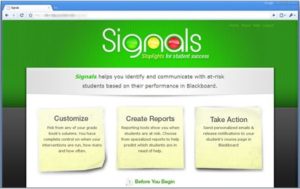
A Purdue University-piloted tool that uses educational technology—and online “signals”—to warn some students that their grades are dropping, offer study-habit suggestions, and provide positive reinforcement to students who are acing quizzes and exams is being released nationally.
“Course Signals” is being made available to higher-education institutions through a joint effort by SunGard Higher Education and Purdue University to help increase student achievement. Course Signals was developed at the university and piloted for three semesters before its 2009 launch. (See “Tech helps students adopt good study habits.”)
“We found in our research that this can improve student [achievement] an average of one letter grade for many students,” said Gerry McCartney, Purdue’s chief information officer, vice president for information technology, and Olga Oesterle England Professor of Information Technology. “Course Signals is an important step forward for higher education that can be implemented successfully at many universities and community colleges across the nation to improve student retention and success.”
Course Signals is an educational technology solution that is built upon a predictive model developed by John Campbell, associate vice president for academic technologies at Purdue. The solution allows an institution to combine information already available within campus systems (including student information systems, learning management systems, and gradebooks) to determine whether a student is at risk of failing or withdrawing from a course as early as the second week of the semester or quarter.
Based on the data, the solution displays a red, yellow, or green signal to students and faculty, indicating a student’s achievement status in a course in real time. A red light indicates a high likelihood of failing; yellow indicates a potential problem of succeeding; and green signals a high likelihood of student achievement. Students view the signal within the institution’s learning management system and also receive it via eMail. Along with the signal, students receive suggested resources and recommended courses of action from faculty as needed.
In its initial release, Course Signals will work with SunGard Higher Education’s Banner Digital Campus and Oracle’s PeopleSoft student information systems. It also supports various releases of learning management systems from Blackboard Inc. Integration with other student information systems and learning management systems is planned.
At Purdue, students logging into their Blackboard learning management system accounts receive frequently updated feedback indicators similar to traffic lights indicating their standing in each class. Each Purdue faculty member using the online system assigns a signal to their students.
“The predictive model in Course Signals gives students a good indication very early in the course of how they are performing and whether they are starting to lag behind others in the class. This very early alert to the student is extremely valuable, even in populations where you might not think it is necessary,” Campbell said. “Signals is helping Purdue improve [student] retention rates by identifying underperforming students early on and providing them with course-specific advice on how to change their trajectory.”
Purdue officials said faculty members who have used Signals often receive thank-you eMails from students grateful for an early heads-up after an early stretch of mediocre or failing grades.
“They don’t feel invisible, even in a very large classroom,” said Nancy Wilson Head, executive director for information technology in Purdue’s Teaching and Learning Technologies Unit, when the program launched last year. “They feel like the faculty member really wants to motivate them to improve.”
The educational technology effort is an example of SunGard Higher Educations Open Digital Campus strategy, which encourages collaboration among customers and with the company.
At Metropolitan Community College-Kansas City, a beta site for Course Signals, the school benefited from features such as the solution’s ability to pull demographic information from the college’s PeopleSoft student information system into the predictive model, and its ease of use for faculty.
“We have a lot of students who are the first in their families to attend college, or who have other demographics that indicate they might be at risk early on,” said Tuesday Stanley, vice chancellor of administrative services and student development at the college. “The other solutions we have seen only consider grades when identifying at-risk students. The inclusion of demographics, as well as effort, is a critical piece of the equation in helping these students succeed.”
“Institutions are facing increased pressure to improve [student] retention and graduation rates. In fact, many states are tying improvements in retention and graduation rates to enrollment funding,” said Tom Wagner, vice president of product management and strategy for SunGard Higher Education’s student retention and success offerings. “Course Signals’ built-in, customizable predictive model, and its focus on faculty and course-level success, is a critical addition to traditional early warning systems as well as to other retention-related solutions and services from SunGard Higher Education.”
- Are AI skills more important than degrees? - May 2, 2024
- Report forecasts a ‘surge’ in GenAI adoption - April 26, 2024
- Where are microcredentials today–and where are they going? - April 22, 2024

